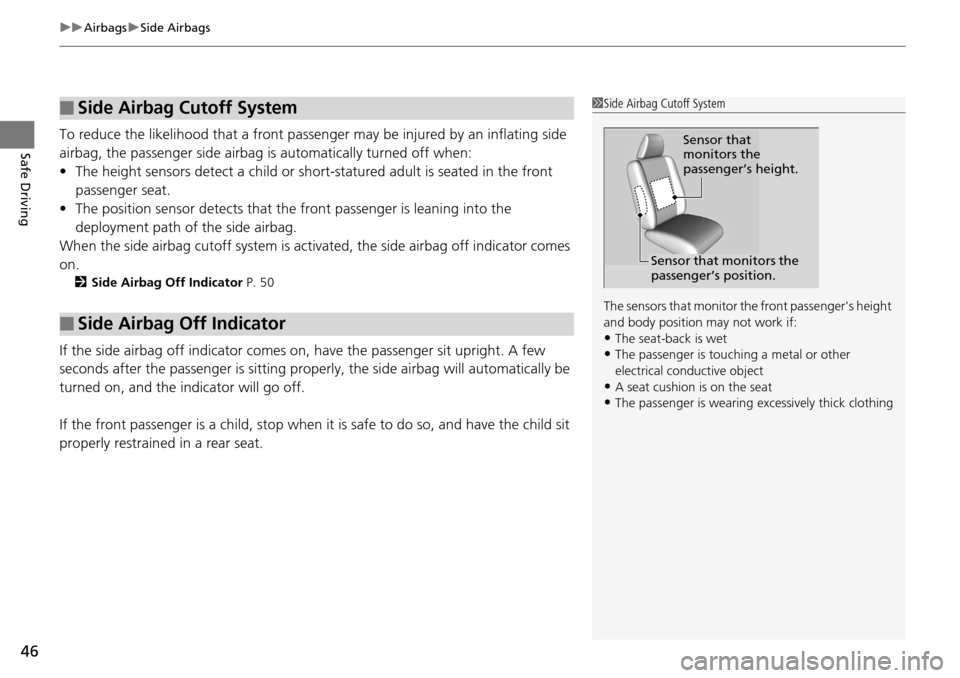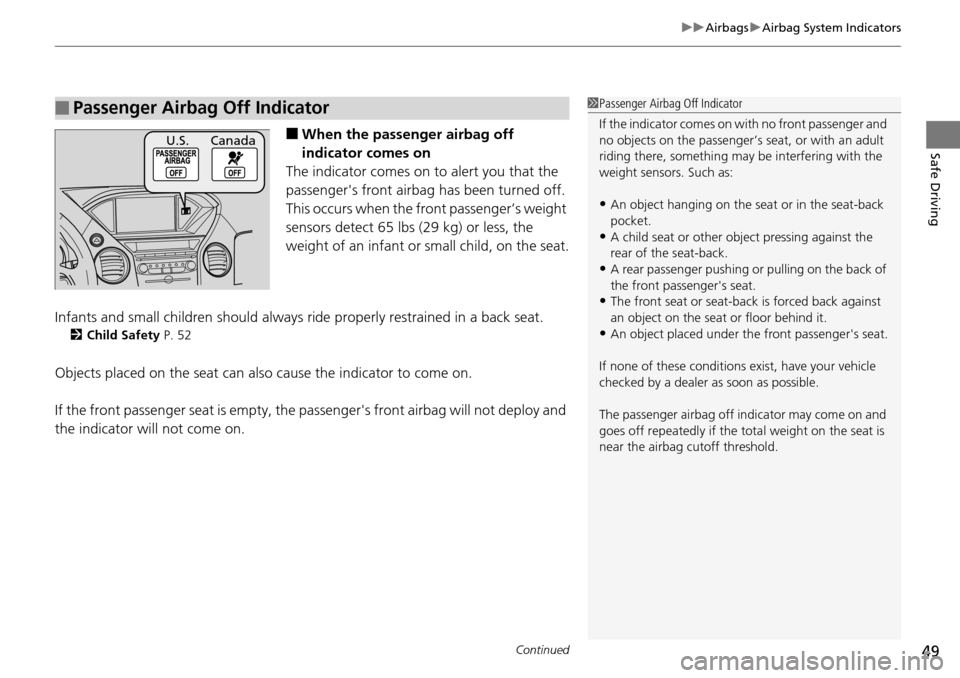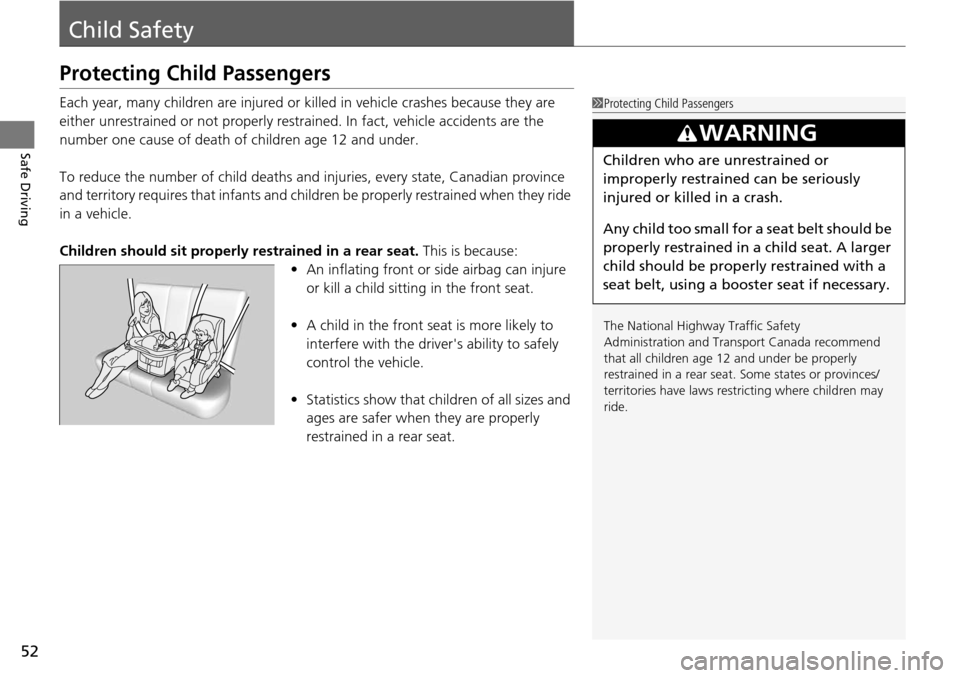Page 45 of 488

44
uu Airbags u Side Airbags
Safe Driving
Side Airbags
The side airbags help protect the upper to rso of the driver or a front passenger
during a moderate-to-severe side impact.
The side airbags are housed in the outside
edge of the
driver's and passenger's seat-
backs.
Both are marked SIDE AIRBAG.
When the sensors detect a moderate-to-
sev
ere side impact, the control unit signals the
side airbag on the impact side to immediately
inflate.
■Housing Locations
1 Side Airbags
Do not attach accessories on or near the side airbags.
They can interfere with the proper operation of the
airbags, or hurt someone if an airbag inflates.
If the impact is on the passenger's side, the airbag
may not deploy when there is no passenger in the
front passenger seat.
Do not cover or replace the front seat-back covers
without consulting a dealer.
Improperly replac ing or covering front seat-back
covers can prevent your si de airbags from properly
deploying during a side impact.
Housing
Location
■Operation
When
inflated
Side
Airbag
Page 46 of 488
45
uu Airbags u Side Airbags
Continued
Safe Driving
■When a side airbag deploys with little or no visible damage
Because the airbag system senses sudden acceleration, a strong impact to the side
of
the vehicle's framework can cause a side airbag to deploy. In such cases, there
may be little or no damage, but the side impact sensors detected a severe enough
impact to deploy the airbag.
■When a side airbag may not deploy, even though visible damage appears
severe
It is possible for a side airbag to not deploy during an impact that results in
apparently
severe damage. This can occu r when the point of impact was towards
the far front or rear of the vehicle, or when the vehicle's crushable body parts
absorbed most of the crash energy. In either case, the side airbag would not have
been needed nor provided protec tion even if it had deployed.
Page 47 of 488

uu Airbags u Side Airbags
46
Safe DrivingTo reduce the likelihood that a front passeng er may be injured by an inflating side
airbag, the passenger side airbag is automatically turned off when:
•The height sensors detect a child or sho rt-statured adult is seated in the front
passenger seat.
• The position
sensor detects that the front passenger is leaning into the
deployment path of the side airbag.
When the side airbag cutoff system is acti vated, the side airbag off indicator comes
on
.
2 Side Airbag Off Indicator P. 50
If the side airbag off indicator comes on, have the passenger sit upright. A few
seconds after the passenger is sitting properly, the side airbag will automatically be
turned on, and the indicator will go off.
If the front passenger is a child, stop when it is safe to do so, and have the child sit
proper
ly restrained in a rear seat.
■Side Airbag Cutoff System
■Side Airbag Off Indicator
1Side Airbag Cutoff System
The sensors that monitor th e front passenger's height
and body position may not work if:
•The seat-back is wet•The passenger is touc hing a metal or other
electrical conductive object
•A seat cushion is on the seat•The passenger is wearing excessively thick clothing
Sensor that
monitors the
passenger’s height.
Sensor that monitors the
passenger’s position.
Page 49 of 488
48
uu Airbags u Airbag System Indicators
Safe Driving
Airbag System Indicators
If a problem occurs in the airbag syst em, the SRS indicator will come on and a
message appears on the multi-information display *.
■When the ignition switch is turned to
ON
(w
The indicator comes on for a few seconds,
then goes off. This tells you the system is
working properly.
If the indicator comes on at any other time, or does
not come on at all, have the
system checked by a dealer as soon as po ssible. If you don't, your airbags and seat
belt tensioners may not work properly when they are needed.
■SRS (Supplemental Restraint System) Indicator1 SRS (Supplemental Restraint System) Indicator
3 WARNING
Ignoring the SRS indicator can result in
serious injury or death if the airbag systems
or tensioners do not work properly.
Have your vehicle checked by a dealer as
soon as possible if th e SRS indicator alerts
you to a possible problem.
* Not available on all models
Page 50 of 488

Continued49
uu Airbags u Airbag System Indicators
Safe Driving■When the passenger airbag off
indicator comes on
The indicator comes on to alert you that the
passenger's front
airbag has been turned off.
This occurs when the front passenger’s weight
s
ensors detect 65 lbs (29 kg) or less, the
weight of an infant or small child, on the seat.
Infants and small children should always ri de proper
ly restrained in a back seat.
2Child Safety P. 52
Objects placed on the seat can also cause the indicator to come on.
If the front passenger seat is empty, the pa s
senger's front airbag will not deploy and
the indicator will not come on.
■Passenger Airbag Off Indicator1 Passenger Airbag Off Indicator
If the indicator comes on wi th no front passenger and
no objects on the passenger’s seat, or with an adult
riding there, something may be interfering with the
weight sensors. Such as:
•An object hanging on the seat or in the seat-back
pocket.
•A child seat or other obj ect pressing against the
rear of the seat-back.
•A rear passenger pushing or pulling on the back of
the front passe nger's seat.
•The front seat or seat-back is forced back against
an object on the seat or floor behind it.
•An object placed under th e front passenger's seat.
If none of these conditions exist, have your vehicle
checked by a dealer as soon as possible.
The passenger airbag off indicator may come on and
goes off repeatedly if the to tal weight on the seat is
near the airbag cutoff threshold.
U.S. Canada
Page 51 of 488
uu Airbags u Airbag System Indicators
50
Safe Driving■When the side airbag off indicator comes on
This indicator comes on if the passenger's side airbag has been turned off because
the passen
ger is too small to be sitting in the front seat, is slouching or not sitting
upright, or has leaned into the airbag's deployment path.
Unless the passenger is a smaller statured ad
ult or a child, the indicator should go
off when the passenger returns to a proper upright sitting position.
■Side Airbag Off Indicator1 Side Airbag Off Indicator
When you turn the ignition switch to ON
(
w
, the
indicator should come on for a few seconds and then
go out. If it doesn't come on, stays on, or comes on
while driving without a pa ssenger in the front seat,
have the system checked by a dealer as soon as
possible.
Canada
U.S. U.S.
Canada
Page 52 of 488

51
uu Airbags u Airbag Care
Safe Driving
Airbag Care
You do not need to, and should not, perform any maintenance on or replace any
airbag system components yourself. However, you should have your vehicle
inspected by a dealer in the following situations:
■When the airbags have deployed
If an airbag has inflated, the control unit an
d other related parts must be replaced.
Similarly, once an automatic seat belt te nsioner has been activated, it must be
replaced.
■When the vehicle has been in a moderate-to-severe collision
Even if the airbags did not infl ate, have your
dealer inspect the following: the driver’s
seat position sensor, weight sensors in the passenger’s seat, front seat belt
tensioners, and each seat belt that was worn during the crash.
■Do not remove or modi fy a front seat without consulting a dealer
This would likely disable the driver's seat p
osition sensor or the passenger’s weight
sensors. If it is necessary to remove or modify a front seat to accommodate a person
with disabilities, contact a Honda dealer , or for U.S. vehicles, American Honda
Automobile Customer Service at 800-99 9-1009 and for Canadian vehicles, Honda
Canada Customer Relations at 888-9-HONDA-9.
1 Airbag Care
We recommend against the use of salvaged airbag
system components, including the airbag, tensioners,
sensors, and control unit.
Page 53 of 488

52
Safe Driving
Child Safety
Protecting Child Passengers
Each year, many children are injured or killed in vehicle crashes because they are
either unrestrained or not properly restra ined. In fact, vehicle accidents are the
number one cause of death of children age 12 and under.
To reduce the number of child deaths and in jurie
s, every state, Canadian province
and territory requires that infants and childre n be properly restrained when they ride
in a vehicle.
Children should sit properly restrained
in a rear seat. This is because:
• An in
flating front or side airbag can injure
or kill a child sitti ng in the front seat.
• A ch
ild in the front seat is more likely to
interfere with the driver 's ability to safely
control the vehicle.
• Statistics show that
children of all sizes and
ages are safer when they are properly
restrained in a rear seat.
1 Protecting Child Passengers
The National Highway Traffic Safety
Administration and Transport Canada recommend
that all children age 12 and under be properly
restrained in a rear seat. Some states or provinces/
territories have laws rest ricting where children may
ride.
3 WARNING
Children who are unrestrained or
improperly restrained can be seriously
injured or killed in a crash.
Any child too small for a seat belt should be
properly restrained in a child seat. A larger
child should be properly restrained with a
seat belt, using a booster seat if necessary.